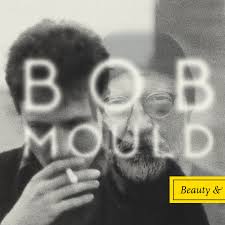It can’t be easy being Bob Mould. For a guy who’s had such an enormous impact on alt rock, there’s a palpable sense that his standing in popular music’s canon isn’t what it should be, with the press release (actually, make that full-scale essay) that accompanies his latest album describing him as "a survivor who refuses to give up", a man who "chooses to confront head-on […] the psychic turbulence that comes with this stage of life." Whoa. This impression of a man undergoing some kind of existential crisis is reinforced by Beauty & Ruin‘s sleeve picture of a grizzled but defiant Mould – looking not unlike Breaking Bad‘s Walter White – juxtaposed with a photo of his younger self as an intense, cigarette-smoking aesthete.
And really, who can blame him for still feeling pissed off after all these years? As the co-founder and main songwriter in Hüsker Dü during the 80s, he combined hardcore ferocity with melodic pop nous, and in the process inspired a plethora of more well-known and successful groups following in his wake, from Pixies to Nirvana to Green Day etc etc. (And if for some crazy reason you’ve skipped past Hüsker Dü in your musical education, take yourself in hand, start with Flip Your Wig, then work forwards and backwards). Then, after a couple of well-received solo albums, he formed Sugar and scored two top ten albums (and NME’s album of the year in 1992) with a slick, post-Nevermind sound.
Yet Mould has often seemed weighed down by this legacy rather than buoyed by it, with reactive if laudable excursions into dance music in the 00s only dividing his core constituency. As a serious artist, it’s entirely understandable that Mould hasn’t wanted to "sit quiet and go idle" in the intervening years since his first run of glory – but I can’t help wondering if he isn’t haunted by a feeling that only by reforming Hüsker Dü will his talent and influence finally receive full recognition. (But those particular psychic scars run very deep indeed, so don’t hold your breath.)
On saying that, Beauty & Ruin suggests that Mould may be coming to terms with his past, and in so doing, has created a partial workaround for the Hüsker Dü issue by accessing some of that old energy and channelling it into his new music. For instance, there’s a clutch of songs on here that could comfortably hold their own on Hüsker Dü’s later albums by virtue of their direct, punkish attack: ‘Little Glass Pill’ establishes a nice hooky riff before rushing headlong into a storm, while ‘Kid With Crooked Face’ is even more breakneck, its speedy major/minor chord structure seemingly designed for the mosh pit. But these aren’t just mindless thrashalongs – as with the best of Mould’s songs, there’s an intensity and intelligence inherent that transforms them into vessels of genuine passion and anger.
Elsewhere, Mould displays his apparently effortless grasp of classic, melodic songwriting. ‘I Don’t Know You Anymore’ is an irresistible, practically archetypal Mould track released as the album’s lead single (complete with amusing video – spot the Wipers album, history fans!). It’s upbeat with a hint of melancholy, as is the semi-acoustic-driven ‘Forgiveness’, its luminous, almost folky vocal line harking back to his first solo album Workbook. It’s easy to forget (or not even realise) that Mould was at the absolute vanguard in opening up the mainstream for this type of smart, hard guitar pop.
Other noteworthy tracks include ‘Low Season’, its brooding, mid-paced swagger making an interesting choice for an album opener (and coincidentally sounding not unlike Low in their heavier moments), and ‘Nemeses Are Laughing’ (and what a title that is), with its swoony "do do do do" refrain. But despite being just 36 minutes long, the album is often the victim of Mould’s proficiency at his own craft, with the latter half in particular sounding pleasant but a bit samey in tone and dynamics. Rather than a big finish, the likes of ‘Let The Beauty Be’ and ‘Fix It’ feel a bit too grown-up and pat in their sentiments and execution. And here it’s tempting to once again invoke the elephantine ghost in Mould’s rehearsal room – the reason that Hüsker Dü were so special was because Grant Hart was the yin to Mould’s yang, providing both a contrasting style of songwriting and an alternate standard to be both judged and challenged by. Competition – friendly or otherwise – often produces the most exciting results.
While Beauty & Ruin contains some of the most vital music of Mould’s solo career, it’d be great to see him properly stretched again as an artist and player. And maybe that requires an even bigger rapprochement with the past.
<div class="fb-comments" data-href="http://thequietus.com/articles/15546-bob-mould-beauty-ruin-review” data-width="550">


